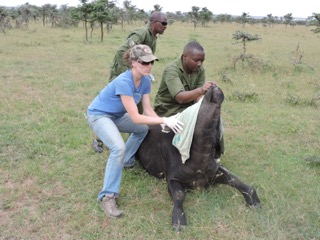Local targeted methods are always the most effective method to halt disease spread.

While the North American livestock industries have not had to deal with some of the world's most significant diseases, research into these global animal health threats — such as foot and mouth disease (FMD) and peste des petits ruminants (PPR) — can help eradicate and/or minimize their spread.
According to researchers at the University of Warwick in the U.K., future FMD outbreaks can be combatted quickly and efficiently at early stages — even when authorities have minimal information on the outbreak — if a new real-time strategy is followed.
Drs. Michael Tildesley and William Probert in the University of Warwick’s School of Life Sciences and Mathematics Institute discovered that the most effective policies for the start of a FMD outbreak are focused on surveillance and vaccination.
Determining the optimal strategy to control FMD can be challenging in the first weeks of an epidemic, due to uncertainty about the nature of the outbreak and how the disease will be spread, the university said. The researchers sought to resolve this uncertainty, enabling the spread of the disease to be controlled more rapidly and effectively than in the past.
Using data from previous FMD outbreaks — specifically, the 2001 outbreak in the U.K. and a 2010 outbreak in Japan — the researchers simulated the spread of disease, and at each stage of the outbreak analyzed the real-time efficacy of multiple different approaches.
These methods included:
* Culling only infected farms;
* Culling infected farms, plus farms designated as dangerous contacts;
* Culling infected farms, dangerous contact farms and neighboring farms (contiguous culling);
* Ring culling at 3 km, and at 10 km, and
* Vaccination at 3 km, and at 10 km.
At every stage of an outbreak, regardless of the uncertainty in case reporting, local targeted approaches (culling of infected premises and ring vaccination around confirmed infected farms) were always found to be the most effective, the researchers said.
On the other hand, ring culling was never an effective method. The researchers concluded that, owing to the spatial uncertainty in model predictions during the early stages of an epidemic, targeted surveillance is crucial to allow authorities to gain information and resolve uncertainty as quickly as possible, ultimately better controlling the spread of the disease earlier in an outbreak.
“This work highlights both the limitations and the benefits of using an infectious disease model in real time, during an ongoing outbreak. It is crucial for policymakers to employ surveillance to resolve uncertainty in how the disease is spreading as rapidly as possible, as this may have significant implications upon our ability to predict future epidemic behavior,” Tildesley said.
Most mathematical models developed for disease control look back to previous outbreaks and make their calculations using all the information from the whole episode — this new strategy is rare in that it works out the best approach with only the information to hand in the middle of an outbreak, the researchers added.
PPR model
After rinderpest, PPR is the disease that the World Organization for Animal Health (OIE), U.N. Food & Agriculture Organization (FAO) and European Union most want to eradicate by 2030, according to CIRAD, the French Agricultural Research Centre for International Development.
CIRAD said this highly contagious disease is currently found in Africa, Asia and the Middle East, and was recently detected in Bulgaria, on the border with Turkey. An article recently published in the journal PNAS suggests a model that serves to prioritize zones for vaccination as an alternative to mass vaccination campaigns, which are both costly and highly complex to implement.
PPR is a highly contagious viral disease affects almost a billion sheep and goats in Africa, the Middle East and Asia. It causes substantial economic losses due to high morbidity and mortality rates. The role of wild ruminants in the spread of the disease is still largely undetermined, but models could be used to understand it better.
Eradicating PPR is an ambitious objective that is looking increasingly realistic, thanks to a targeted vaccination strategy centering on production systems that act as a virus reservoir, CIRAD said.
In theory, the PPR control strategy relies on mass vaccination campaigns. However, although the existing vaccine provides lifelong immunity, such campaigns are both costly and highly complex to implement from a logistical point of view.
The study was initiated by CIRAD and conducted by the Royal Veterinary College (RVC) at the University of London in the U.K., in collaboration with Ethiopian and European partners. The researchers combined a dynamic model that simulates virus spread with a national serological study.
The information obtained served to assess the level of virus transmission within endemic zones and the vaccine coverage required to halt transmission and eliminate the disease, CIRAD said. The results also suggested that some pastoral production systems act as virus reservoirs from which the virus can spread.
RVC epidemiologist Guillaume Fournié said, "Identifying high-risk populations and adapting vaccination strategies to local situations is vital in order to cut the cost of eradicating the disease while boosting the chances of success."
CIRAD epidemiologist and study co-author François Roger pointed out that PPR "causes huge economic losses and is a particular threat to the livelihoods and food security of the most vulnerable farmers. In view of the limited budgets currently allocated for control of the disease and the numerous constraints in the field, effective decision support tools are vital."
OIE and FAO, with EU support, have launched a global program to eradicate the disease within 15 years. This would make PPR the third infectious disease to be eradicated, after smallpox and rinderpest.
OIE and FAO will hold a PPR global conference Sept. 6-7 in Brussels, Belgium, to provide a platform for high-level political interventions; for representatives from affected and at-risk countries and regions to set forth their experiences, challenges and commitments, and for resource partners to express their pledges for support.
About the Author(s)
You May Also Like



